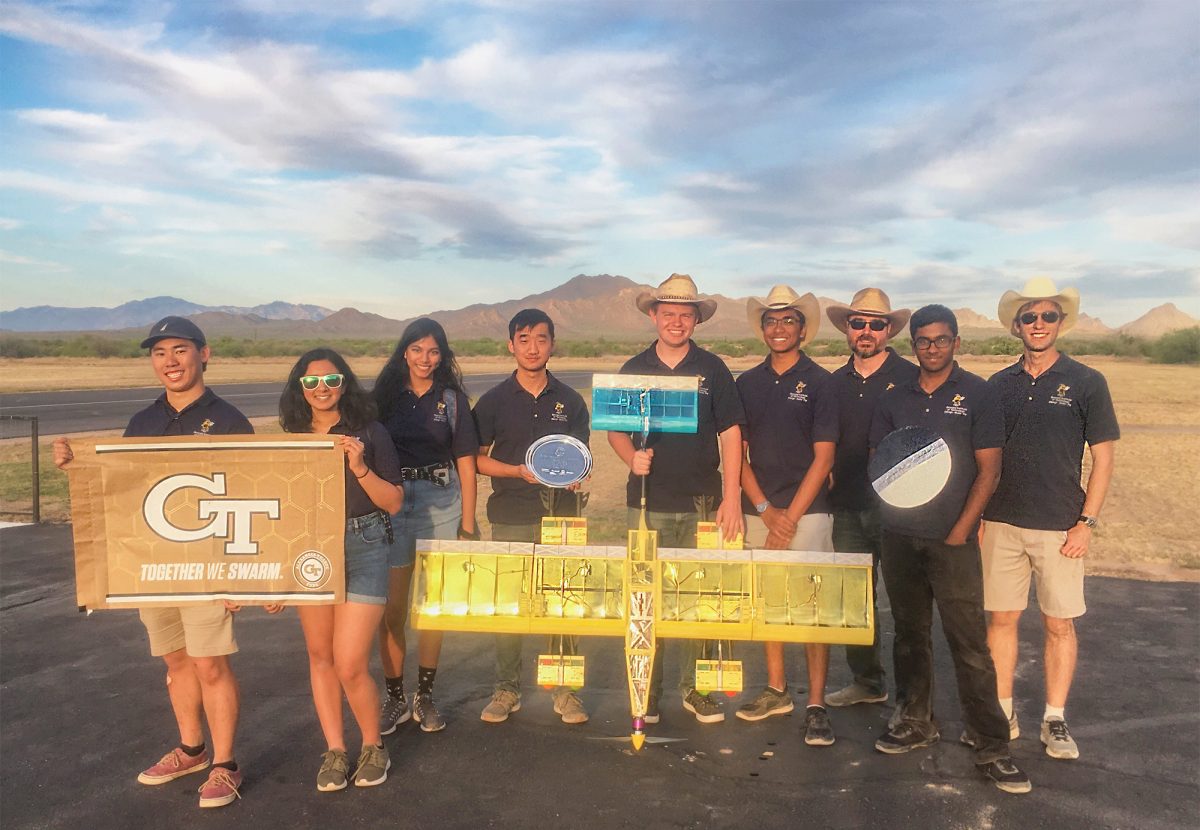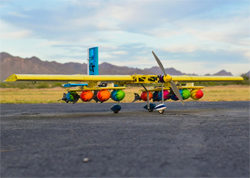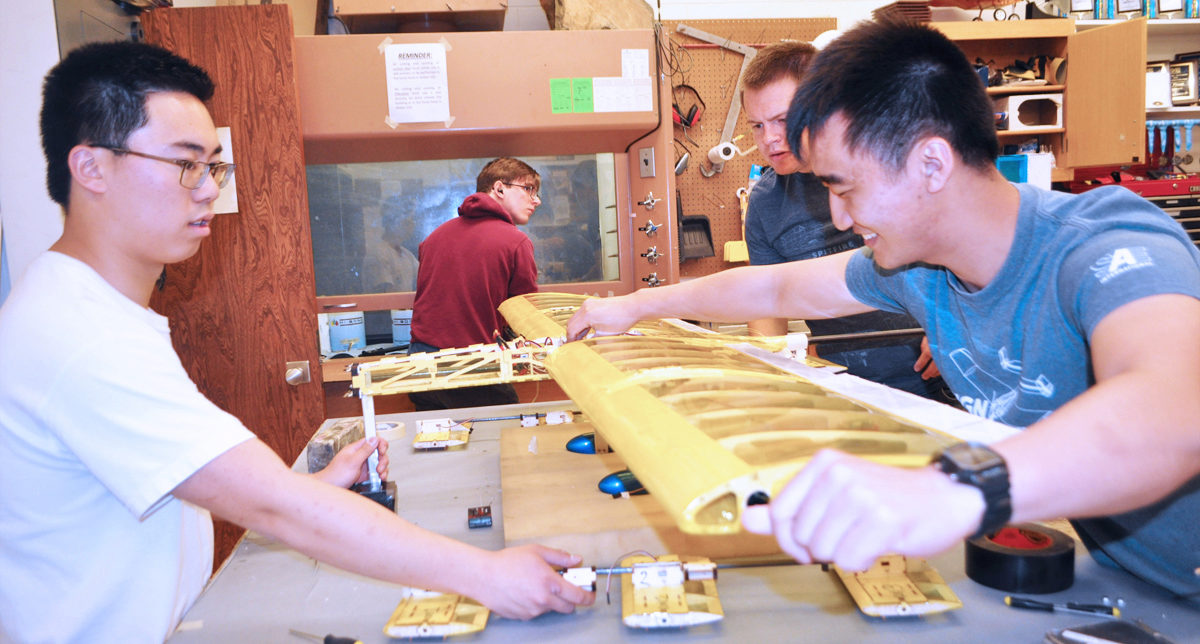
Taking it Home from Tucson: Posing with their award-winning aircraft, Buzzformer are (l to r) Tristan Huang, Harshini Sivakumar, Tithi Mandal, Eddie Li, Scott Nealon, Gowtham Venkatachalam, Carl Johnson, Arun Palaniappan, Matt Warren
A team of students from AE’s Aerospace Systems Design Lab (ASDL) took home second place at the AIAA Design Build Fly Competition, April 11 – 14.
The team's twelve-pound, battery-operated aircraft - Buzzformer - completed three flight missions and one ground mission to best 102 other teams during the four-day competition, held in Tucson.
“It is gratifying when our student teams do well in competitions like the AIAA Design Build Fly," said Regents Professor, Dimitri Mavris, ASDL's director.
"To see all their hard work pay off and get recognized from such a large field of contestants is rewarding for the students as well as all of us in AE, and we are extremely proud of them.”
 |
| Eddie Li |
The specs for this year's competition tasked teams to operate within the constraints typically encountered on Naval aircraft carriers: aircraft have a limited take-off distance for their launch, they need to be optimally stored to save space, and they have to be moved from hangar to flight deck using aircraft elevators.
In reviewing the entries, judges looked for students who were thinking outside the box – and inside it, too.
“We had to design a carrier-operated, reconnaissance, and ground attack aircraft that measured 24 inches from nose to tail and could still fit inside a 2-foot-by-3-foot box. That’s where it got challenging,” said team captain, Eddie Li.
Some of those challenges turned into lessons. After Buzzformer crashed to the ground during a test flight last November, the team developed a spring-loaded ferrule to stabilize the wings.
“Our original locking mechanism in the wings didn’t hold up during flight, so we had to come up with a completely new design,” Li added. That redesign kept Buzzformer in the sky during the competition.
 |
| Carl Johnson |
In all three flight missions vehicles were launched off a 10-foot ramp. Vehicles were restrained from an arresting hook, held by a team member, and then released when full take-off thrust was achieved.
"The challenge with the ramp is that the competition only allows you to take off in one of two directions, so if there are crosswinds in either direction, it can cause a really difficult take-off," said Li.
Luckily, the wind was in Buzzformer's favor during competition weekend.
Mission I
Buzzformer breezed through mission one, which challenged aircraft to complete three laps around a 2,000-foot course with two 360-degree turns - all within five minutes. This test of basic functionality allowed the judges to evaluate the aircraft's readiness for missions that would get progressively more difficult.
Mission II
In mission two students had to add a remote-controlled, rotating radome - a dome-shaped instrument often used by the Navy to detect submarines. Buzzformer's radome did not possess actual radar capabilities, but it had to meet real-world specs: a circumference of at least 12-inches, a thickness of one-inch in the center, and an ability to be turned on and off repeatedly during its five-minute flight.
At first, Buzzformer seemed to have performed perfectly during this phase of the competition. When it landed, the team learned otherwise.
 |
| Tristan Huang |
"We noticed the batteries were smoking and the landing gear attachment was broken. It turns out that a good portion of the bottom of the fuselage got charred from the batteries," said Li.
After limiting the batteries' current draw, Buzzformer passed re-inspection and had a successful flight.
Mission III
In mission III, Buzzformer satisfied a new requirement -- the addition of attack stores -- by affixing foam football darts to the vehicle. The team that dropped the most of these attack stores during their 10-minute mission scored the most points. One catch: no more than one attack store could be dropped during each lap. Buzzformer dropped a respectable 14 attack stores on its best attempt.
But there were some glitches.
During day two of the competition Buzzformer accidentally dropped four of its 15 attack stores.
"The rubber bands on the attack store mechanism lost tension due to the heat," said ASDL research engineer, Carl Johnson, the DBF advisor. "We tightened them up and added some fishing line to ensure that they would only release when commanded."
After tweaking and testing, the team also discovered that loading the attack stores from the front made it likely that they would stay put during each flight.
Ground Mission
 |
| Buzzformer holding 16 attack stores |
In the final leg of the competition, Buzzformer, the radome, and four attack stores were staged inside a marked 10-foot-by-10-foot area. When signaled, team members ran to the aircraft, assembled the radome, rushed back to their starting point, and had their radome tested by officials. They then removed the radome and repeated the process for the attack stores.
The faster the assembly time, the better the score.
"I was able to complete the ground mission in about 24 seconds during practice, but during the competition I fell on my way back from the staging box, which cost us a few seconds," said second-year AE student Tristan Huang.
"It was really fun, and stressful, but that's to be expected," he said. "We didn't have any test flights to see if our adjustments would work. We had to have complete trust in our semesters-worth of work and our pilot, and it all came together in the end," Huang concluded.
The team captain agreed, adding:
"I’m really proud with how far we’ve come as a team since the start of fall semester,” said Li. “We’ve had five iterations of Buzzformer since the start of the competition, and, through each change and new configuration, we’ve come together as a team and learned something new."

Making Final Adjustments: Before going to Tucson, AE students (l to r) Tristan Huang, Scott Nealon, and Eddie Li made sure Buzzformer was ready to be packed and flown. To save room, the wings had to be able to be folded.